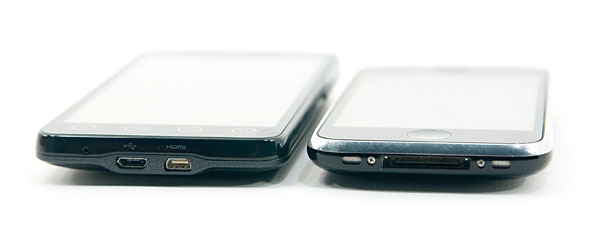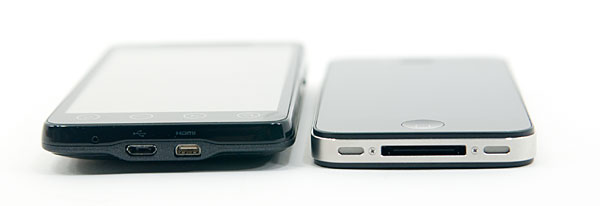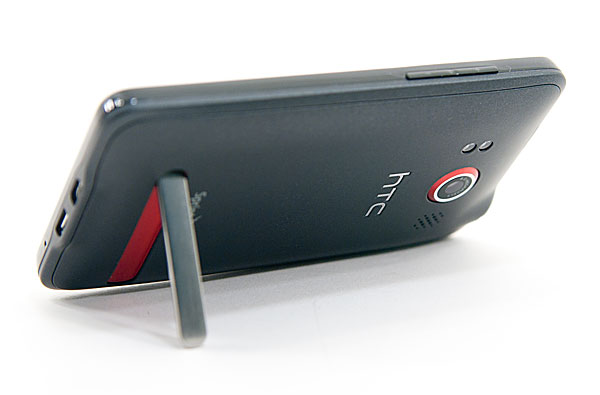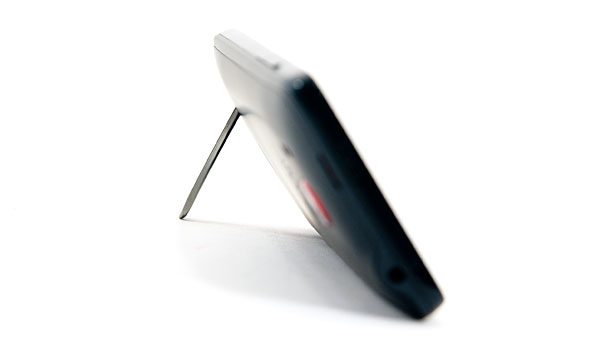The Sprint HTC EVO 4G Review
by Anand Lal Shimpi on June 28, 2010 6:04 PM ESTIt’s really not that big. It seems like it would be based on the specs and photos, but in reality the Sprint EVO 4G by HTC just isn’t that big. And it’s not levied as an insult, I just mean to say that the EVO is manageable in size.
The screen has the same 800 x 480 resolution of the Nexus One and HTC Incredible, but the pixels are spread out over a much larger 4.3” screen. The display setup to be overly red just like the other Android screens we've seen thus far, but it looks great.

The size of the screen is really what sets the EVO 4G apart from the competition, and honestly I couldn’t think of a better phone for browsing the web. Loading full websites is a pleasure and the screen is large enough where you can actually read a lot of content. It's not a tablet replacement, but it is easier to work with than a 3.5 - 3.7" screen.

From left to right: HTC EVO 4G, iPhone 3GS, Nexus One, iPhone 4
I’ve heard it referred to as a mini tablet and honestly I don’t believe that’s the case. The 4.3” screen is big but I’m telling you, it’s not that big in practice. It just ends up feeling like a phone with a good sized screen. Move into the 5” and beyond territory and then you start triggering me calling things tablets.

HTC EVO 4G (left) vs. iPhone 3GS (right)

HTC EVO 4G (left) vs. iPhone 4 (right)
The phone measures 4.8” x 2.6” x 0.5” and it’s the largest smartphone I’ve ever held. That being said, it is absolutely pocketable as long as you’re not wearing skinny jeans. Even then it is thin enough that you could slip it into your back pocket.
| Physical Comparison | |||||||
| HTC EVO 4G (Qualcomm Snapdragon QSD8650) | HTC Droid Incredible (Qualcomm Snapdragon QSD8650) | Apple iPhone 4 | Google Nexus One (Qualcomm Snapdragon QSD8250) | ||||
| Height | 121.9 mm (4.8") | 117.5 mm (4.63") | 115.2 mm (4.5") | 119 mm (4.7") | |||
| Width | 66.0 mm (2.6") | 58.5 mm (2.30") | 58.6 mm (2.31") | 59.8 mm (2.35") | |||
| Depth | 12.7 mm (0.5") | 11.9 mm (0.47") | 9.3 mm ( 0.37") | 11.5 mm (0.45") | |||
| Weight | 170 g (6.0 oz) | 130 g (4.6 oz) | 137 g (4.8 oz) | 130 g (4.6 oz) | |||
| CPU | Qualcomm Scorpion @ 1GHz | Qualcomm Scorpion @ 1GHz | Apple A4 @ ~800MHz | Qualcomm Scorpion @ 1GHz | |||
| GPU | Adreno 200 | Adreno 200 | PowerVR SGX 535 | Adreno 200 | |||
| RAM | 512MB LPDDR1 | 512MB LPDDR1 | 512MB LPDDR1 (?) | 512MB LPDDR1 | |||
| NAND | 8GB micro SD | 8GB micro SD | 16GB or 32GB integrated | micro SD | |||
| Camera | 8MP with dual LED Flash + Front Facing Camera | 8MP with LED Flash | 5MP with LED Flash + Front Facing Camera | 5MP with LED Flash | |||
| Screen | 4.3" 480 x 800 | 3.7" 480 x 800 AMOLED | 3.5" 640 x 960 LED backlit LCD | 3.7" 480 x 800 AMOLED | |||
| Battery | Removable 5.5Whr | Removable 4.81 Whr | Integrated 5.254 Whr | Removable 5.18 Whr | |||
HTC ditched the silly scroll ball of the Nexus One and the optical sensor of the Incredible and just left the EVO 4G with a row of touch sensitive buttons along the base of the screen. Home, Menu, Back and Search are all you get.
If you need a navigational aid the screen is big enough where HTC was able to include directional arrows on the on-screen keyboard. They are awkward to use at first because you’re not used to them, but afterwards they just make sense. I hardly used the scroll ball/optical trackball of the other Android phones so HTC’s decision to reclaim that real estate makes total sense to me. The screen is used for scrolling, if you need fine tuned movement just rely on the virtual arrow keys. Fine by me.
The touch screen supports haptics, which can be fully disabled. When enabled certain button presses will cause the EVO’s motor to vibrate a bit to confirm the touch. It’s a concession for those who still want some tactile feedback.

The EVO 4G is the first Android phone I’ve used with something interesting on its back: a kickstand. The metal stand lets you prop a horizontally oriented EVO on your desk at around a 45 degree angle. It’s great for watching videos, using as a clock or an alternative to a costly dock.

The stand is actually a nice touch, unfortunately the Android UI doesn’t rotate to landscape mode so it’s only useful within apps that support rotation.
Also on the back is the 8MP camera lens (there’s a 1.3MP camera on the front), two LED lights used as a flash and a speaker for the speakerphone. Along the bottom is a standard USB micro B connector and a micro HDMI (D-connector) video out. The HDMI out can only be used to output movies, it won’t mirror your display.

As its name bluntly states, the EVO 4G works on Sprint’s 4G WiMAX network. Sprint’s 4G service is currently only available in 43 cities spread over 15 states, if you find yourself in one of those states then the EVO has more than its large screen to tempt you.
The phone currently sells subsidized for $199 from Sprint after a $100 mail in rebate. Service starts at $69.99 for 450 minutes and unlimited messaging/data and goes all the way up to $134.99 per month including tethering.
| Cost of Ownership Comparison | |||||
| AT&T iPhone 4 | Sprint EVO 4G | Verizon HTC Droid Incredible | |||
| Cost of Device | $199 w/ 2 year contract | $199 w/ 2 year contract after $100 MIR | $199 w/ 2 year contract | ||
| Plan with 900 Minutes, Unlimited SMS/Data | $104.99/mo, unlimited SMS, 2GB data | $99.99/mo, unlimited SMS, unlimited data, 4G | $109.98/mo, unlimited SMS, unlimited data | ||
| Tethering | + $20/mo | + $29.99/mo | + $25/mo* | ||
| Total Monthly + Tethering | $124.99/mo | $129.98/mo | $134.98/mo | ||
| Total Cost of Ownership over 2 Years | $2718.76 | $2598.76 after $100 MIR | $2838.52 | ||
| Total Cost of Ownership over 2 Years w/ Tethering | $3198.76 | $3318.52 after $100 MIR | $3438.52 | ||
Without the mobile hotspot service, the EVO 4G is the most affordable smartphone out of the three majors over the course of two years. AT&T actually offers a better deal with tethering but you need to keep an eye on your usage; go over 2GB per month and you'll incur additional charges, which isn't tough to do if you tether a lot.










97 Comments
View All Comments
JimmiG - Monday, June 28, 2010 - link
Amazing how expensive plans are over there compared to where I live.I have unlimited data at 6Mb/s and make calls for the equivalent of 5 cents a minute. That costs $26 a month (plus the cost for any calls or texts). There are cheaper alternatives if you only need 1GB or 5GB of data month. Sure, there's no subsidized phone included, but I just bought an unlocked HTC Desire (~Nexus One), it costs about the same as a high-end netbook.
Over 24 months I pay maybe half of the quoted prices, one-time cost of phone included.
chriscusano - Monday, June 28, 2010 - link
Where is there?DigitalFreak - Monday, June 28, 2010 - link
Considering he's getting 6Mb/s, I'd have to assume somewhere in Europe. :-)JimmiG - Thursday, July 1, 2010 - link
I'm in Sweden which is why I was even more surprised. Everything tends to be more expensive here, not cheaper.Another operator offers 1GB/month at 6Mb/s for $9 a month and 5GB/month at 10Mb/s for $16 a month. But I choose unlimited data over the higher speed since stuff like HD video is kind of pointless on a 3.7" screen.
Of course you don't always get those speeds. Some 3G areas, especially in rural areas, don't support HSDPA so you only get 384Kb/s. But most built-up areas have at least 2Mb speeds and the entire city where I live offers the full bandwidth.
strikeback03 - Tuesday, June 29, 2010 - link
So what would it cost for about 1500 minutes, 6000 SMS, and 200 MMS?Gamingphreek - Monday, June 28, 2010 - link
Anand,I have found SIGNIFICANT performance and battery improvements in using LauncherPro by Federico Carnales on my HTC Hero <www.launcherpro.com>. I would be interested to hear if you notice the same thing.
Additionally, while it is only for root users, Autokiller is a terrific application for modifying the Android's preset memory limits.
Finally, regarding internet use, Dolphin Browser HD 2 is head and shoulders above the stock browser in every aspect. You may consider trying and seeing if that makes a difference in the browsing tests.
Great review regardless, but as a long time Android user, I have found these to make a significant positive impact on my overall experience with the device.
I know adding different applications to review can get out of hand very quickly, but is there any chance we might hear about your experience with some of these aforementioned applications?
Thanks,
-Kevin
chriscusano - Monday, June 28, 2010 - link
Hey great thoughts. Well I don't have an android myself, but maybe you guys might want to consider writing up an article (after official 2.2 release I'm thinking) with a phone "fully optimized" using some of the best (and cheapeast/free) apps out there. I think a phone with these apps will be sigificantly better than a stock phone. It's *almost* like comparing an oem computer out of the box to a customized computer (with a few performance tweaks). All serious computer users as well have their own customized setups that make their experience much, much better than a standard one (choice of web browser w/ addons/extensions, cutomized start bar, useful desktop gadgets, etc). Truly the experience can be totally different when things are customized. I'd image the same is the case with a phone like this.Also, man I've been looking for some VOIP 4G tests. Help me out guys! I may try to downsize to one internet carrier for home and phone but my major concern is I NEED VOIP for work. Can 4G cut it if the signal strength is strong (from a static location)? Does tethering via USB to the computer affect internet speeds? If so, how is VOIP from the computer when tethering via USB? Anyone? Anand ? :)
-Chris
Gamingphreek - Tuesday, June 29, 2010 - link
I have an HTC Hero, so I'll have to run all the tests over before I do it with the apps, but I would be more than happy to run a couple tests and send in a short little article for Anand's consideration. I can post it in the forums too just for general knowledge.My undergraduate research prior to my graduation this past May was on the Android OS (More specifically how secure it was from an IT Security perspective).
Impulses - Tuesday, June 29, 2010 - link
There's a ton of things you can do to optimize battery life, from alternate launchers, to custom ROMs, to simply configuring the stock sync settings for the various accounts. Something Anand made no mention of, and it's one of the more obvious tweaks, the stock settings are actually pretty poor if you wanna preserve battery life but they're easy to change from 2-4 hours to 8 hours or daily or w/e.The latter alone made a difference for me, but some of the custom ROMs and such make a very very noticeable difference as well. It's really quite amazing what some of the user devs come up with, it puts Google/HTC's stock builds to shame. I've no idea if the iPhone jailbreak community delves into that kind of low-level optimization but the stuff they're doing on Android's end is awesome.
misaki - Monday, June 28, 2010 - link
Froyo is now getting rolled out officially, so I hope you guys will include it in your browsing comparisons since the speed gains are so drastic ;)